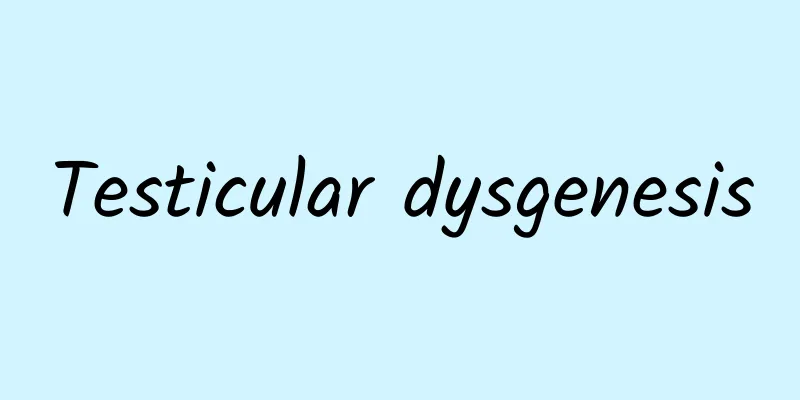Testicular dysgenesis

|
Testicular dysplasia can cause mental retardation and poor sperm quality in men, and also affect male sexual desire. Therefore, we should treat this congenital disease in a timely manner, otherwise it will damage the fertility of male patients. For the symptoms and examination methods of testicular dysplasia, we can learn about the content introduced in this article. 1. Clinical manifestations This disease lacks obvious clinical symptoms before puberty, and only a few have mild mental retardation and behavioral abnormalities. During puberty, obvious underdevelopment of male secondary sexual characteristics appears. 1. Mental retardation: Most patients with this disease have normal intelligence, and about 1/4 of patients have mild mental retardation. Clinical studies have found that the more sex chromosomes (X chromosomes) there are, the more severe the incidence and degree of mental retardation. 2. Mental abnormality: The main characteristics are emotional indifference, lack of initiative and poor thinking. Children with this disease are often shy, withdrawn, taciturn and unsociable. Some children also show excessive and abnormal dependence on their parents, often skip school and wander outside, and may even behave improperly. Some children may show neurotic tendencies and even psychotic symptoms. Studies have found that the incidence of schizophrenia in children with this disease is several times higher than that of the normal population. 3. Developmental disorders of secondary sexual characteristics: The patient looks like a man, but has small testicles (about 2 cm in length), a small penis, and may also have cryptorchidism, hypospadias, low libido, azoospermia, etc., and is generally infertile. 10-30% of children with this condition are feminine, such as breasts, sparse body hair, no beard, delicate skin, developed subcutaneous fat, an inconspicuous Adam's apple, a slender figure, and especially obvious growth of the lower limbs. 4. Deformities and abnormal skin texture: There may be microcephaly and skeletal deformities, such as radial and ulnar synostosis, cubitus valgus, knee and hip valgus, etc.; eye deformities, such as severe visual impairment, iris, choroid, pigment membrane rupture or iris absence, etc. 2. Laboratory Inspection 1. Chromosome karyotype analysis The chromosome karyotype of normal males is 46, XY, while the typical karyotype of children with congenital testicular dysgenesis is 47, XXY. In addition, mosaic and variant types may also occur. 2. Endocrine changes After the children enter puberty, the testosterone level in the blood decreases or becomes lower than normal, the gonadotropin levels in the blood and urine increase, the follicle-stimulating hormone and luteinizing hormone both increase, and the urinary 17-ketosteroid decreases. This is due to the insufficient endocrine function of the testicular interstitial cells, which reduces the inhibitory effect on the pituitary gland's secretion of gonadotropin. 3. Diagnosis and differential diagnosis Based on the incomplete development of male secondary sexual characteristics, abnormal external genitalia, delayed intellectual development, abnormal behavior, etc., further analysis of oral mucosal sex chromatin and chromosome karyotype can confirm the diagnosis. This disease should be differentiated from delayed puberty. The sex chromatin of this disease is positive, while the sex chromatin of delayed syndrome is negative; in this disease, there is generally a large amount of gonadotropin during puberty, while delayed syndrome lacks this type of hormone; testicular biopsy of this disease can show the above-mentioned abnormal pathological changes. IV. Treatment and Prognosis Androgen replacement therapy is used. Generally, testosterone can be given intramuscularly in the early puberty (11-12 years old), 1-2 times a week, 25-50 mg each time. After sexual development improves, the maintenance dose is continued. It is generally believed that secondary sexual characteristics develop after treatment, but it cannot promote testicular development and restore fertility. Children with the disease may survive to adulthood, but are prone to developing malignant tumors, especially breast cancer, which has a very high incidence rate. They may also be complicated by testicular teratoma, spermatoepithelioma, leukemia, etc. |
>>: One side of the testicle is enlarged
Recommend
What are the dangers of neck massage for neck pain?
Bad habits such as working with your head down fo...
Is surgery good for premature ejaculation?
According to current medical conditions, some pre...
The glans penis secretes white and smells fishy
Men's health is a concern for many people, es...
Why do men urinate frequently?
Genital diseases caused by long-term smoking and ...
Men prefer to eat this food, which will kill sperm unknowingly!
For most men, a low sperm count may lead to infer...
How to take care of circumcision surgery after surgery
Sexual intercourse often affects the harmony of a...
Which department is better for orchitis and epididymitis?
The testicles and epididymis are important compon...
Diet therapy for chronic prostatitis
Male friends must take good care of the preventio...
What are the benefits of leg press for men?
Men generally bear greater pressure in life, whic...
Men are in danger of crises when they reach 40. What kind of women do they like?
Men in their forties have already entered a fairl...
Red pimples on inner thigh of man
The reason why men have big red bumps near the ba...
Men can't eat these things. Eating too much will cause impotence.
There are many reasons for impotence, such as irr...
How to lose elephant legs for boys
In fact, not only girls, I believe every man also...
Poor blood circulation in the glans penis
The glans penis is an important part of the male ...
Itching and red spots on male genitals
Male scrotal itching may be scrotal itching or sc...









